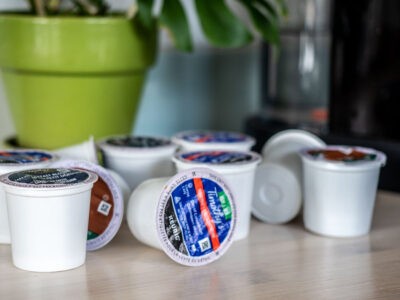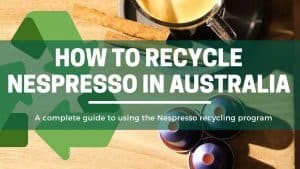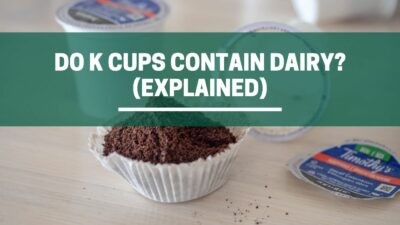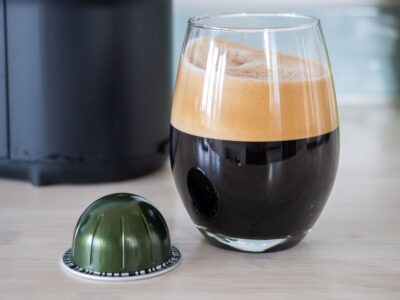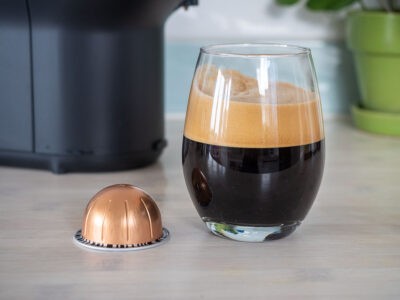Keurig Guides, Keurig Machines
Why Does My Keurig Coffee Taste Burnt? (+ How To Fix It!)
While Keurig can get a bad rap for brewing bland coffee, when paired with a good quality pod, it produces java that packs a punch. But when your favorite blend and much-loved brewer produce a burnt-tasting coffee, it does make you question its efficiency.
The reason your coffee tastes burnt might be:
- The machine needs cleaning
- The machine needs descaling
- The temperature settings are off
- You’ve selected the wrong cup size
- You’re using robusta coffee
- Your tap water is hard
- You’re using poor-quality capsules
- You’re using expired or unsealed pods
- The machine is defective
So before you bury it in your cabinet, carry on reading to find out why burnt-tasting coffee happens and techniques to make a tasty cup of joe.
Why Listen To Us? Well, because we KNOW coffee! In fact, we make our own coffee, coffee machine cleaners, and reusable capsules which we've sold to over 41 countries. Our team ouf experts include Tristan (an engineer), Claire (a food writer) and Richy (a barista). So, whether you're looking for a recipe or repair guide, we've got you covered 💚
Table of Contents
What We Mean By “Burnt Tasting” Coffee
“Burnt tasting” coffee has an unpleasant and overpowering bitter, charred, or smoky taste. Coffee beans that have been sitting around for too long can produce a burnt or bitter taste.
But there are several other factors that contribute to burnt, sour, or bitter coffee.

9 Reasons Why Your Keurig Tastes Burnt, Sour, Or Bitter
We surveyed our customers and did our own testing to find the most likely reason your coffee is tasting burnt.
1. You have not regularly cleaned your machine
Any parts of your brewer that interact with grinds are bound to be tainted by coffee oils. If you put off cleaning for too long, flavors from the previous brew will transfer into your fresh brew. Follow the steps below to clean the holder and needle on your Keurig.
Cleaning the holder
- Place the mug on the drip tray.
- Run a water-only brew by selecting the largest cup size.
You can also clean the holder using Keurig rinse pods.
Cleaning the needle
Cleaning the exit nozzle
- Power off the brewer.
- Unplug the machine and remove the water reservoir.
- Remove the pod holder by gently pulling it away from the brewer.
- Insert the clip into the exit needle to loosen any clogs.
- Rinse it thoroughly under running water.
- Reattach it to the housing.
Cleaning the entrance nozzle.
Underneath the brewer’s head, you’ll see the entrance needle.
- Insert the paper clip and move it around in a circular motion to remove any clogs.
- Put the capsule holder into the brewer.
- Reattach the water reservoir to the brewer.
2. Keurig machine needs descaling
Keurig recommends you descale your appliance every 3-6 months. If you’ve been neglecting this crucial maintenance step, it will be worth your while to set aside 30 minutes to an hour and give the appliance a deep clean. Descaling not only removes coffee residue, but it also gets rid of limescale build-up. Build-up can clog your machine, resulting in under-extracted coffee.
Not the right machine for you? Check out our other descaling guides for Keurig coffee machines below:
3. Keurig’s temperature settings
Most brewers have a preset temperature of 89℃ (192℉), while some models, like the K-Elite and Keurig 2.0, have a temperature control feature that allows you to select temperatures between 86-89℃ (187-192℉).
If you selected the lowest temperature, reset the machine to the highest temperature for a balanced extraction. For preset temperature models, run a small-cup brew cycle without a capsule to warm the brewer and mug, and then brew your coffee.
4. Using the wrong cup size setting
If you brew a large cup size with a small-sized pod, more water passes through the coffee grounds, resulting in a burnt or bitter taste. Alternatively, if you brew a small-sized cup with a large cup pod, too little water passes through the coffee grounds, resulting in a sour or acidic taste.
5. It’s the type and roast of coffee you’re using
The most prevalent coffee variety is robusta. It has low growing requirements, making it cheaper and readily available. Not only does it have a high caffeine content, but it also has a robust taste because of its high chlorogenic acid content.
If you’re looking for a mellow alternative, purchase Arabica coffee. Depending on the roast, you can find strong and bold blends without the bitter aftertaste. Also, be conscious of the type of roasts you use. Medium-dark and dark roasts have an intense ashy taste.
6. Your water is too hard
Hard water is laden with calcium, magnesium, and carbonate, which contribute to a bitter, dull, and often chalky coffee.
7. You are using expired or unsealed K-Cups
Your pods are filled with regular ground coffee, and as with all fresh grinds, they don’t have an infinite shelf life. You can check the expiry date or best-by date on the capsule sleeves or test the freshness of your pods by gently pressing the aluminum cover. If it bounces back, it’s still usable. If not, it’s possible a hole let oxygen in, oxidized your coffee grounds, and increased the acidity of the coffee grounds, resulting in sour coffee.
8. You’re using poor-quality 3rd party K-Cups
While you might be tempted to try other brands because they’re cheaper, not all capsules are of the same quality. Some manufacturers don’t evenly roast their own beans, while some use low-quality beans. The beans produce a sour, watery coffee.
Our Recommendation: Check out this article for the best Keurig K-Cups in 2023 for some tasty pods that won’t break the bank or some of our other recommendations below
9. It’s a defect in your Keurig machine
When you’ve ruled out all the above as potential causes of vile-tasting coffee, then it might mean your machine is defective. If your machine is still within warranty, you can book it in for repairs.
Our Top 4 Tips To Make Your Keurig Coffee Not Taste Burnt
1. Clean your machine
Follow the steps below to clean your appliance with rinse pods.
- Place a large container on the drip tray.
- Put the rinse pod on the pod holder.
- Select the 8oz brew size.
- Remove and discard the rinse pod.
- Discard the rinse solution.
- Return the container to the drip tray.
- Run an 8oz water rinse cycle.
- Discard the water.
2. Filter your water
If you have extremely hard water, you can invest in a filter pitcher to pacify the mineral content.
3. Use the right cup size
While a K-cup can brew up to 354ml (12 ounces), we found the sweet spot is between 177ml and 236ml (6-8 oz). If you want a larger cup, it’s best to brew twice to reap the full flavor.
4. Fill your own reusable K-Cups
Using a reusable K-Cup puts you in control of the type of coffee and roast you use. If you find that dark roasts are the culprit of burnt-tasting coffee, you can switch to light or medium roasts. You also have the option to fill them up as much as you wish (just don’t exceed the Max line), allowing you to control the extraction rate.
Frequently Asked Questions
Q. Why does my k-cup coffee taste burnt?
The reason your k-cup coffee tastes burnt is that:
1. You haven’t regularly cleaned your brewer.
2. The brewer needs descaling
3. You’re using the wrong cup size setting
4. You’re using a dark roast or robusta coffee
5. Your tap water is too hard
6. You’re using expired or unsealed K-cups
7. You’re using poor-quality third-party K-cups
8. Your machine is defective
Q. Why is my Keurig still bitter after descaling?
Maybe you have not flushed out all the residual solution n your machine. Sometimes, there might be some limescale lingering in the brewer. The best agents to use are descaling agents. they effectively cut down limescale. Try running another descale cycle using agents like the Keurig descaler.
Q. How do I make my Keurig not taste bitter?
To prevent your Keurig from tasting bitter, you can:
1. Clean and descale your machine.
2. Use good quality pods.
3. Brew with filtered water.
Q. Does descaling Keurig improve the taste?
Descaling your Keurig does improve the taste of your coffee. The process removes limescale and coffee oil buildup.
Q. How do I know if my Keurig K-Cups have gone bad?
You can check the expiry date on the sleeves. Or do a freshness test by pushing the aluminum foil. If it bounces back, the capsules are still safe to use. If not, discard them and get a pack of fresh pods.
Q. Will cleaning the Keurig make coffee taste better?
Cleaning the Keurig will make the coffee taste better, even more so when you use Keurig rinse pods. They effectively remove residue and scale.
Conclusion
Various factors can result in a burnt-tasting Keurig coffee. These include the type of capsules you use, your water temperature, your tap water hardness, and the cleanliness of your machine.
To achieve a balanced and delicious cup of coffee, invest in the best-quality capsules, descale your machine regularly, and use a water purifying system to reduce the potency of the minerals in your tap water.
Related Posts
The 5 Best Keurig K Cup Subscriptions (In 2024)
A coffee subscription is a lifesaver. No more do you have to bleary-eyed wonder how [...]
Can You Drink Expired K-Cups? (Check This!)
We’ve all been there – discovering boxes of old K cups in the back of [...]
10 High Caffeine K Cups (The Strongest We Found!)
Are you not getting a buzz out of your regular K-Cup coffee? Or want to [...]
The 7 Best Keurig K-Cups For Weight Loss
Keurig k-cups have earned their spot in the marketplace. They’re convenient and there’s a k-cup [...]
1 Comments





